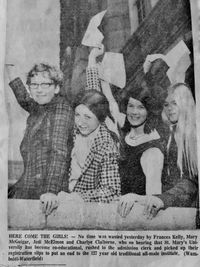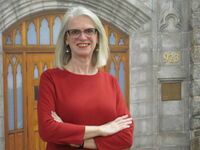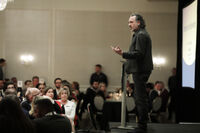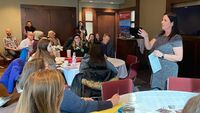By Renée Hartleib |
It was September of 1968, and Frances Murdock (nee Kelly) was just about to turn seventeen. She was enrolled at Mount St. Vincent University and discovered that the textbooks for her Fall term courses were in short supply. She and a few friends set off for the Saint Mary’s Bookstore to see if the missing titles were available there.
“Little did we know, SMU had just announced it was going co-ed,” says Frances. “When we got there, some of the male students started pointing and shouting, ‘There are the new girls!’, and even though we weren’t there to enrol, we got swept up in the excitement.”
Frances and her friends waltzed over to the Admissions Office and left with white admission forms fluttering in the breeze. Just in time for their pic to be snapped by a Halifax MailStar reporter. Here Come the Girls was the headline on the front page of the newspaper the next morning. Frances and her friends were proclaimed as the first women to register at Saint Mary’s.
“When I got home, I had to convince my parents this was a sensible idea, and I had to do it before they saw the newspaper!” Frances succeeded and became one of only 50 full-time female students to register in that first year. She went on to earn her BA and her MEd and then taught school for 40 years in Halifax.
It was a time of immense change in the world and also a rich period in the history of Saint Mary’s. The Vietnam War was at its peak, and classes were peppered with draft dodgers. There were regular protests outside the President’s Office. Members of the Black Panthers visited the University. And the Journal—SMU’s student newspaper—was filled with irate and opinionated editorials.
One of the areas of heated debate was the topic of co-education. In the years preceding the advent of women on campus, there were a number of men who publicly claimed it was a very bad idea. Inviting women in would dampen the school spirit and lower the school’s academic standing; these were a few of the arguments floated. But the administration was changing. Long a Jesuit-run institution, the University was undergoing secularization and becoming public – one that had to compete with other regional and national universities. In a taped recording that lives in the Saint Mary’s University Archives at the Patrick Power Library, Father William A. Stewart—faculty and administration member from 1950-1982—remarked that trying to remain solely a boys’ school in the late 1960s was not only impossible, it was also hindering the university’s growth. Stewart was one of the first Saint Mary’s professors to advocate for change and promote educational inclusivity for women and other marginalized communities.
“Many would say that this initial opening of the doors to women has paved the way to the kind of inclusiveness that Saint Mary’s prides itself on today,” says Bridget Brownlow, SMU’s Conflict Resolution Advisor. She is referring to the fact that more than one quarter of the University’s students are international and come from 80 different countries around the world.
Brownlow wrote an entire thesis on the conflict inherent in secularization and co-education and how it was managed by SMU during the years 1967-1970. “Saint Mary’s really stepped up to the plate and actively participated in the wave of cultural change that was happening at that time,” she says. “It’s interesting to note that 50 years later, the number of female students actually now surpasses that of male students.” So, what was life like for those first 50 female students? While most have wonderful memories of their time at SMU, many admit that entering an all-male university wasn’t a bed of roses.
For the first little while, there wasn’t even a women’s washroom. Female students couldn’t stay in residence and had trouble finding a common space on campus to meet. Worst of all, some of these women had to deal with inappropriate and sexist comments from fellow students, and sometimes faculty.
One of the early champions for women students was Dr. Elizabeth Chard. She was the first full-time female faculty member, hired in 1961. She worked in the department of history, but when the University became co-educational, she also assumed the position of Dean of Women and the next year became Dean of the Women’s Residence. Chard had a 44-year history with Saint Mary’s and is known for many great accomplishments, but the women who first joined the University in 1968 remember her as someone who truly cared about students and acted as a mentor to many.
Another one of the first 50 women was Haligonian Chris Butler (nee Parker). After a wonderful summer working at the Halifax Citadel in 1968, the 21-year-old decided that her major would be History. Already a student at the Mount, she was disappointed to realize that she would not be able to get the credits she needed there. “When SMU made the decision to go co-ed, it seemed like the answer I was looking for.”
She loved her history courses and reports that all of her professors, save one, were supportive of female students. It was in one of these classes that she met her future husband and entered into a relationship that has lasted 46 years.
Together, they had three children (one of whom—Signa Butler, also a SMU alum—appears on this issue’s cover). Chris went on to study education at Saint Mary’s and then teach and act as a librarian assistant in the Halifax public education system.
In addition to finding mates for life, many of the first 50 found friends for life. Chris became fast friends with Mary-Evelyn Ternan (featured on page 29), who already knew Frances. Together they studied, smoked in a little sitting area right outside the library, and participated in some late night fun and games.
It was a whole new world of ideas and freedom, and 50 years later, many of these interesting and accomplished women still get together regularly and catch up.
“I can’t believe how fast time has passed,” says Frances. “Going to SMU was a blessing which opened a whole new world to me. I learned to listen, to observe, to think, to care, and to act. My years at SMU started me off on what has become a great life.”




